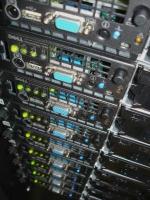 This is the third cluster at CFU and the newest and largest cluster installed. It is designed for simulation and fast processing of the vast amount of data acquired for synthetic aperture imaging. Often, 16 Gbytes of data is acquired per 3 seconds of measurements.
This is the third cluster at CFU and the newest and largest cluster installed. It is designed for simulation and fast processing of the vast amount of data acquired for synthetic aperture imaging. Often, 16 Gbytes of data is acquired per 3 seconds of measurements.
This massive amount of data has to be processed and with the old cluster it may take weeks for just one data set. With the new cluster, it should be possible to do in one day.
The cluster was fully installed with cooling in 2005.
Processors
The cluster consists of 50 Dell 1750 servers each housing two Intel Xeon 3.06 GHz processors for a total of 100 processors.
Storage
Each computer has 2 Gbytes of internal RAM, a total of 100 Gbytes of RAM in the full cluster. The computers also house a fast 10,000 RPM, 146 Gbytes SCSI disk with an access time of 4.7 ms and a peak transfer rate of 320 Mbytes/sec. The combined disk space is 7.3 Tbytes (7,300,000,000,000 bytes). This is equivalent to 1,550 DVD films.
The disk space can be accessed through NFS or via the Parallel Virtual File System (PVFS) developed at Clemson University and Argonne National Laboratory. The cluster is also connected to CFU's two RAID towers housing 3 Tbytes and 1 Tbytes. Thus, the combined storage at CFU is 10.3 Tbytes.
Network
Each computer is equipped with two 1 Gbit/second Ethernet connections that are switched through a HP Procure 2848 and a 2824 switch. Therefore, all computers can communicate with all other computers at a speed of 1 Gbit/second, and 50 Gbit/second can be routed through the system.
Performance
Each Xeon processor in the system has a theoretical peak performance of 6 Gflops, the theoretical maximum performance being 0.6 Tflops. The world's fastest computer, situated in Japan, has a peak performance of 35 Tflops and the size of a football field.
A Matlab version 6.5 executed benchmark using Linpack gives a rating of 1.57 Gflops (1.570.000.000 double precision multiplications per second) per CPU, resulting in a cluster performance of 157 Gflops. This is 16.5 times faster than CFU's cluster 1.
The calculated rating compared to the Top 500 computers in the world can be performed using the NCSA Tungsten computer (the world's fifth fastest computer). This uses the same Dell server as Cluster 2 and gives a rating Rmax of 393 and an Rpeak of 612. No computer in Denmark is on the Top 500 list, but Cluster 2 is probably among the 5-10 fastest computers in Denmark.
The performance of the system can also be compared to the first computers used in the Ultrasound group: the Apollo DN3000 from 1987. It had a Linpack performance of 72 kflops. Hence, the new cluster is 2.2 million times faster than the DN3000. This means, that a program running for a full year on the DN3000 would take 14.6 seconds on the new cluster.
The parallel file system can use all disks in parallel. Theoretically, 5 Gbytes of data per second can be either stored or read by the cluster.